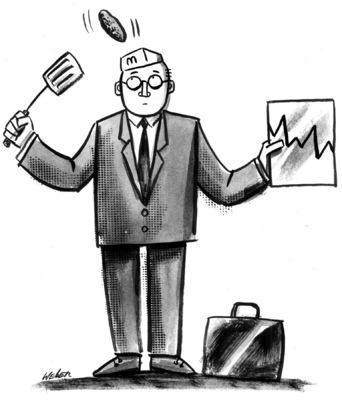- MENU
- HOME
- SEARCH
- VIDEOS
- WORLD
- MAIN
- AFRICA
- ASIA
- BALKANS
- EUROPE
- LATIN AMERICA
- MIDDLE EAST
- United Kingdom
- United States
- Argentina
- Australia
- Austria
- Benelux
- Brazil
- Canada
- China
- France
- Germany
- Greece
- Hungary
- India
- Indonesia
- Ireland
- Israel
- Italy
- Japan
- Korea
- Mexico
- New Zealand
- Pakistan
- Philippines
- Poland
- Russia
- South Africa
- Spain
- Taiwan
- Turkey
- USA
- BUSINESS
- WEALTH
- STOCKS
- TECH
- HEALTH
- LIFESTYLE
- ENTERTAINMENT
- SPORTS
- RSS
- iHaveNet.com: Economy
by Liz Wolgemuth

The brutal truth about the
Employers cut 467,000 jobs last month, according to the report.
The unemployment rate -- a measure of the percentage of workers who are unemployed and looking for work -- rose slightly to 9.5 percent, from 9.4 percent in May.
How are employees getting hammered?
Workers are seeing their livelihoods sliced and diced in numerous ways. For one, the average workweek hit 33.0 hours, a record low since the data were first collected 45 years ago. While hourly earnings have jumped 2.7 percent in the past year, that rise has been mitigated as companies have cut workers' hours -- so, weekly earnings have risen by just 0.9 percent.
Job losses in June were spread widely
Manufacturing lost another 136,000 jobs. Construction employment fell by 79,000. Professional and business services employment dropped by 118,000. Healthcare was the lone sector to add jobs in the month.
While the number of freshly unemployed workers has ticked down, the number of long-term unemployed is heading up. In fact, the
Is there any good news?
There is, indeed, a significant strip of silver lining in this report.
May job cuts total a revised 322,000 -- about half the total jobs employers had cut in each of the previous six months. The fact that June job cuts total 467,000 very likely signifies that workers are through the roughest patch. Also, the unemployment rate increased just 0.1 percentage points, which is less than many economists had expected.
One fact to note: Many of those temporary census jobs that had given the job numbers a boost in previous month are now ending. Employment in the federal government dropped by 49,000 this month, largely because of the census job layoffs.
What can we expect from Washington?
Over the past couple of weeks, the
The study projected that without stimulus funds, unemployment would top out at 9 percent, and with a stimulus, it would smack 8 percent and begin ticking back down. While we will never know what the unemployment rate would have been without the $787 billion spending package, we know now that the rate will probably top at least 10 percent -- with the package.
The uglier than expected job market is leading some, like economist Paul Krugman, to champion a second stimulus package. However, much of the first stimulus package has not yet been spent. It's a multiyear plan.
What are the experts saying?
Richard Moody, chief economist of
"So much for the second derivative test, at least when the subject is the June employment report. Total nonfarm employment fell by a larger than expected 467,000 jobs in June, with job losses broad-based amongst the private and public sectors.
The details of the June employment go from bad to worse -- aside from the unemployment rate rising to 9.5 percent (with the broader U6 measure rising to 16.5 percent) the median duration of unemployment rose sharply, while the share of the unemployed who have lost their jobs permanently rising to a record high 53.5 percent."
Ted Wieseman and David Greenlaw of
"The smaller than anticipated uptick in the unemployment rate was largely attributable to an outright decline in the labor force. Indeed, we are finally starting to see signs of the long awaited pullback in the labor force participation rate.
Here is what we said in last month's Data Bulletin regarding an unexpected uptick in the participation rate: "This sort of rise in the participation rate is very unusual at this stage of the economic cycle -- typically, an increasing number of individuals become discouraged when employment prospects are bleak and they drop out of the labor force. We suspect that the recent rise in the labor force reflects statistical noise that will be reversed in coming months (note: the household survey is based on a very small sample size of about 0.06 percent and the data can be very volatile on a month-to-month basis). A pullback in the labor force should help to temper further increases in the unemployment rate."
However, even with some further slippage in labor force participation, it still looks like the jobless rate will easily breach the 10 percent threshold within the next few months."
Joshua Shapiro, chief U.S. economist at MFR:
"Yes, the drop in payroll employment has moderated from the 700,000+ results reported over the winter when panic and paralysis was the order of the day. But, private sector job losses in excess of 400,000 this deep into a recession cannot be viewed as anything but terrible news."
© U.S. News & World Report
WORLD | AFRICA | ASIA | EUROPE | LATIN AMERICA | MIDDLE EAST | UNITED STATES | ECONOMY | EDUCATION | ENVIRONMENT | FOREIGN POLICY | POLITICS
Why June Jobs Report Is So Depressing